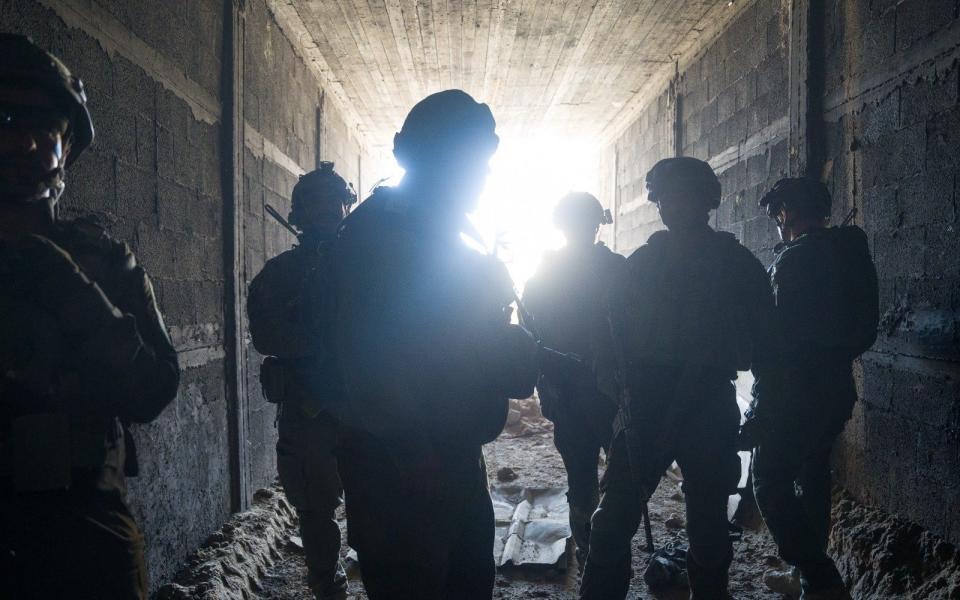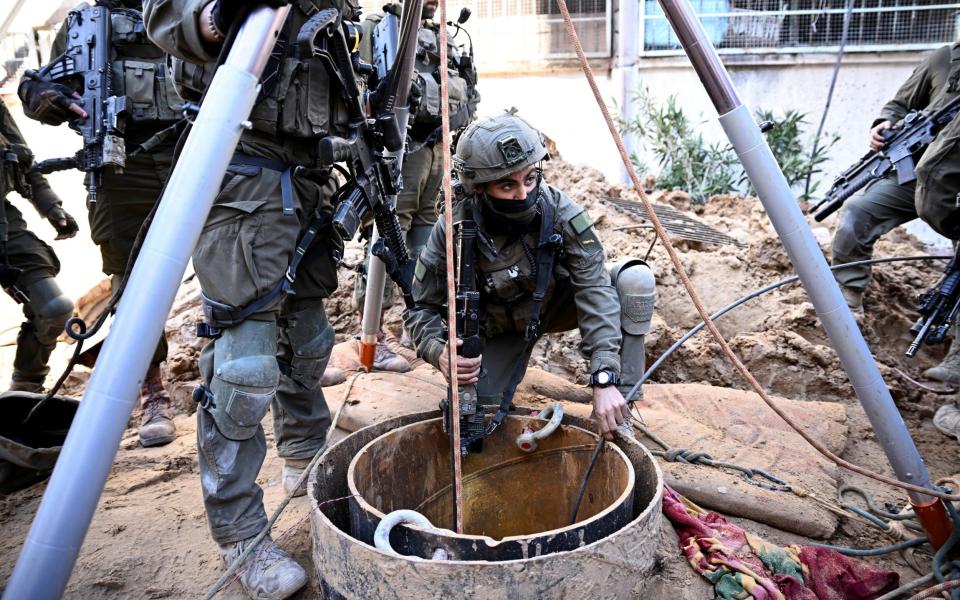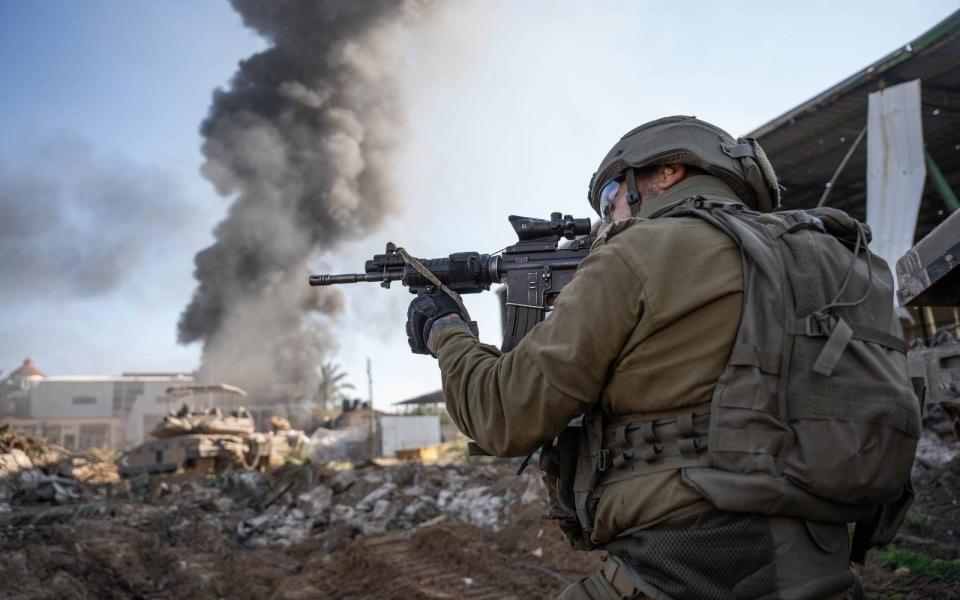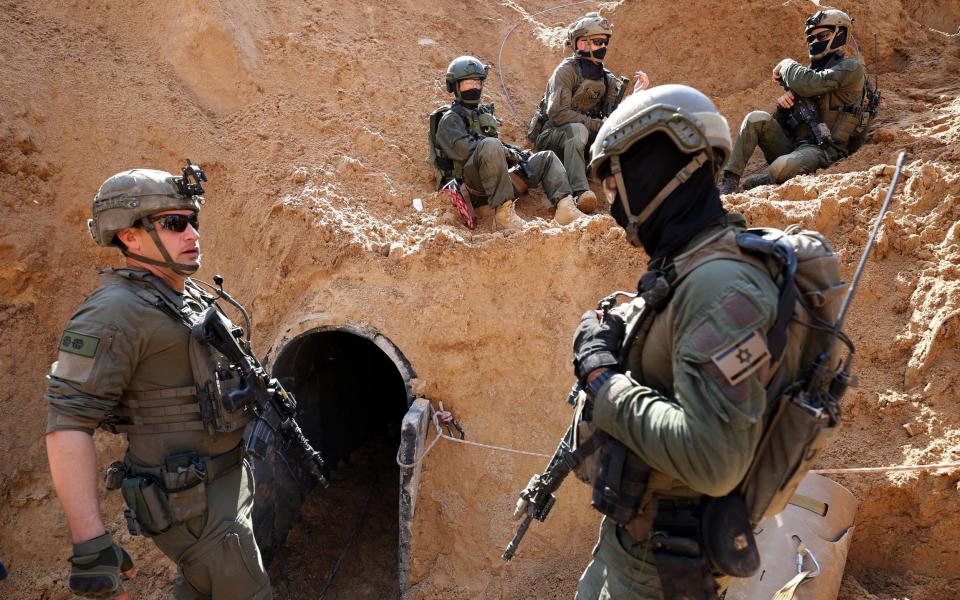When politicians have allowed the Israel Defence Force to operate, it has swept through Gaza like a whirlwind.
About 50 per cent of Hamas terrorists have been killed, according to Israel, and as the anniversary of the war approaches, the remainder are only able to fight a guerrilla insurgency.
It has been anything but easy. The secret of the IDF’s success? Combat in the darkness underground.
Initially bamboozled by an elusive enemy moving like ghosts, Israeli forces came to realise the tunnels were Hamas’s centre of gravity.
A new doctrine was developed to deal with them. This involved co-ordinating air support, special forces, regular infantry, armour and naval assets on the surface and in the tunnels.
“If you want to understand how to manoeuvre in Gaza, think from underground up and manoeuvre your forces simultaneously on the surface and in the tunnels,” one general told me.

These ambitious military tactics had never been attempted before. Maintaining effective communication between such a range of forces so that they worked seamlessly, without firing on each other, was a challenge.
But the approach is bearing fruit. At the start of the war, the Israel Defence Force (IDF) was able to clear up to 100 feet of territory a day and did not dare enter the tunnels. Today, its troops can manoeuvre faster underground than on the surface.
Israel’s initial approach
Before the new tactics were developed, the approach was simple. A “technological blanket” was placed over Gaza, allowing commanders in the field to call in an air strike on any position within three minutes.
Troops would evacuate civilians from an area, clear it of the enemy and bomb any shafts they found. Then they would advance to the next patch.
But rockets would soon be launched from the very place they had just cleared. With so many shafts to choose from, terrorists were simply slipping away underground and returning when the IDF moved on.
The Israelis realised they had underestimated the catacombs. Hamas was able to travel the entire length of Gaza underground, in a single network of remarkable proportions. Although Gaza is just 25 miles long, this labyrinth spanned 300 miles, bigger than the London Underground.


The terrorists’ tactics were as infuriating as they were deadly. The tunnels, which had been under construction since 2006, allowed them to materialise and dematerialise at will, exposing themselves only fleetingly.
They would appear alarmingly close to Israeli forces, attack, then vanish again. Their weapon of choice was the new Al-Yassin 105 rocket-propelled grenade, a homemade flying explosive.
Although it has an effective range of just 250 feet, its dual-charge payload has the capacity to penetrate the reactive armour of Israeli Merkava tanks then explode inside them.
Shafts ‘in every building’
Nothing is sacred in Gaza. According to IDF commanders, there is “not one mosque, school or hospital that does not contain a Hamas shaft”, with openings even discovered inside graves.
Israeli soldiers recuperating in vacated homes in Gaza discovered tunnels under their feet which could be opened via a mechanism in the floor tiles.
Troops declared houses safe, only to be attacked at close quarters without warning. That was why so much of the Strip’s infrastructure had to be destroyed, the IDF said.


The shallowest part of the tunnel network resembled an asymmetrical candelabra. Several vertical shafts led to one horizontal tunnel serviced by a main artery, from which branched other horizontal tunnels and shafts.
A few yards from the surface, there were defensive doors to block pursuers and protect against explosions.
This system connected to larger subterranean highways running the length of Gaza, which led to atria containing offices, guard rooms and living quarters, sometimes complete with barred cells for the Israeli captives.
Decision to go underground
With Israeli soldiers dying on the surface, there was a need to finish this quickly.
The tunnels mostly rely on solar power, but energy is also allegedly syphoned out of schools, mosques, municipal buildings and United Nations facilities above ground (a Hamas intelligence centre was allegedly discovered beneath an UNRWA headquarters in February, its power cables threaded into the building).
Water is stored underground in tanks and plumbed through the network, alongside a rudimentary sewage system.
Switching off the power and enforcing a full siege would starve and suffocate the enemy but it would also deprive civilians of the essentials, creating a humanitarian catastrophe.
Instead, the IDF was forced to send its young men into the darkness. A special task force was created, drawn from different disciplines across the armed forces.
Lessons were learned every day: leaders held debriefs both in the morning and the evening to absorb new insights and adapt tactics accordingly.
Compared to the volume of studies into combat on the surface, in the air, at sea and in space, there is very little research on underground warfare. One model was the campaign conducted against the Americans in tunnels on the island of Iwo Jima by the Japanese during the Second World War.
Civilian casualties reduced
But although fighting underground is dangerous for Israeli servicemen, it does keep civilian casualties down.
Not expecting the IDF to enter the tunnels, Hamas had permitted no Palestinian civilians to shelter there. This allowed the soldiers to enter the labyrinth and shoot on sight, while watching out for Israeli hostages.
At the end of 2023, the first soldiers descended into the earth, assisted by infra-red vision, high-tech navigation gadgets and dogs with cameras on their backs who were given instructions by radio.


The IDF’s canine unit has attack dogs, search-and-rescue dogs and dogs trained to detect explosives. Sometimes they were able to lower cameras into the tunnels attached to explosives which could be detonated when terrorists were seen approaching.
It quickly became clear that the subterranean world had not been designed for combat. There were no trap-doors, alcoves or other cover. There were relatively few booby-traps and the tunnels tended to be long and straight, making them difficult to defend.
Rather, they had been designed to evade hostilities on the surface and manoeuvre around Gaza without detection. “The enemy was using flashlights,” one commander said. “Nobody looks for a fight with a flashlight.”
Systematic tunnel network
The network was built on a pattern that repeated throughout Gaza. The shafts led to narrow tunnels with arched ceilings built to a standard height of five-and-a-half feet, meaning that troops had to hunch as they advanced.
Arabic directions were spray-painted on the walls, which helped the soldiers to navigate, though they mainly relied on advanced technological solutions.
Despite the ventilation, the labyrinth was dominated by a musty smell, to which soldiers adapted. The walls and floors were made of rectangular concrete slabs, imprinted with a distinctive logo. Commanders developed the ability to spot openings on the surface by recognising branded materials around them.
The deeper tunnels were wider, opening out into larger rooms with ceilings ten feet high. Each atrium hosted an identical cluster of bathrooms, bedrooms, guard rooms and offices, complete with telephones and electricity.
The living quarters were more comfortable, with green Astroturf underfoot, brown-and-white patterned tiles on the walls, electric fans and storage for personal effects.
There were many jars of extra-strong vitamins for pregnant women. “We captured some terrorists who had been in the tunnels for 60 days,” one commander told me. “They were ruined.” The bathrooms were tiled white with purple stripes.
The cells for the Israeli hostages were cramped, with a thin mattress on the floor, tiled walls and a lavatory in the rear that was visible through the bars.
In the areas reserved for commanders there were lockable gates, such as those seen in the CCTV footage of Hamas leader Yahya Sinwar under Khan Younis, which was filmed on Oct 10. These were used to keep lower ranks from entering leadership zones.
“It is huge. Amazing. Mind blowing,” one officer said. “As a commander, I take my hat off to their infrastructure.”
Shallow headquarters
One aspect of the labyrinth that took the IDF by surprise was the location of the various underground headquarters. They had expected them to be deeply buried, but figures like Rafa’a Salameh, the Khan Younis commander who played a key role in planning October 7 and was killed in an air strike in July, used offices buried just 50-65 feet below his family home.
“His daily working life was underground,” one general said. “We were amazed. There was no need for him to appear above ground. He had his office with telephones and connectivity in the tunnels, then he would walk up a shaft into his home.”
Many of these command centres included cells for Israeli hostages, suggesting that the terrorists may have intended to rely on human shields to ward off attacks. “They have a different way of thinking,” the general said.


Hamas responded to Israeli underground warfare by using booby traps in the tunnels, adapting as the IDF adapted. They used 40kg Shawaz explosives, triggered via a wire by someone on the other side of the tunnel wall. As they could not be detonated remotely, their effectiveness was limited.
The interconnectedness of the network offered the IDF an advantage: soldiers could access any point from any other point, so if they responded to a sighting quickly, they could hunt the terrorists underground, trap them and kill them.
“Once I manoeuvre into the tunnel, they smell me a mile away,” one soldier told me. “So we start moving very fast and efficiently underground, navigating using our technology.”
Blistering progress
The pace of progress has been blistering. When the IDF entered Khan Younis in December, it took them four months to clear 37 miles of tunnels.
Months later, in Shejaiya, they destroyed a similar network in just two weeks, over June and July.
The IDF now plans its manoeuvres from the catacombs upwards.
“We have learned to combine our operations,” a commander said. “Today, when I plan manoeuvres, I do it underground and above ground simultaneously to achieve the best objective.”
Special forces and regular infantry advance simultaneously, both on the surface and under the ground.
“We leave one opening free to enable them to be flushed out, so we can gather intelligence,” the commander said. “It is frustrating and it takes time. But this way of thinking is our new doctrine.”
Not all soldiers are able to cope underground. Some find it claustrophobic and terrifying. But if Hamas is to be defeated, another October 7 is to be avoided, and the region to have a chance of peace, conquering the catacombs is crucial.
According to Israeli intelligence, many terrorists have blended into the civilian population in humanitarian zones and plan to return to their tunnels once Israel withdraws. For this reason alone, the network must be destroyed.
Philadelphi corridor
As I write, the IDF is scouring the Philadelphi corridor, a nine-mile strip of land along the Gaza border threaded with more than two hundred tunnels into Egypt used for smuggling.
Combat engineers are drilling down to the water table every seven metres, lowering fibre-optic cameras and blowing up any burrows that they find. And so the campaign grinds gradually towards victory.
Every Israeli child grows up singing a folk song written by Baruch Chait, the rabbi, and popularised by the Yemenite singer Ofra Haza.
“The whole world is like a very narrow bridge and the most important thing is not to be afraid,” the lyrics say.
As the IDF presses Hamas towards the abyss by sending its young men to fight the jihadis in the blackness of the tunnels, with the Government in the UK suspending arms licences and international pressure mounting, they are having to draw on this spirit more than ever.
Jake Wallis Simons is the editor of the Jewish Chronicle
